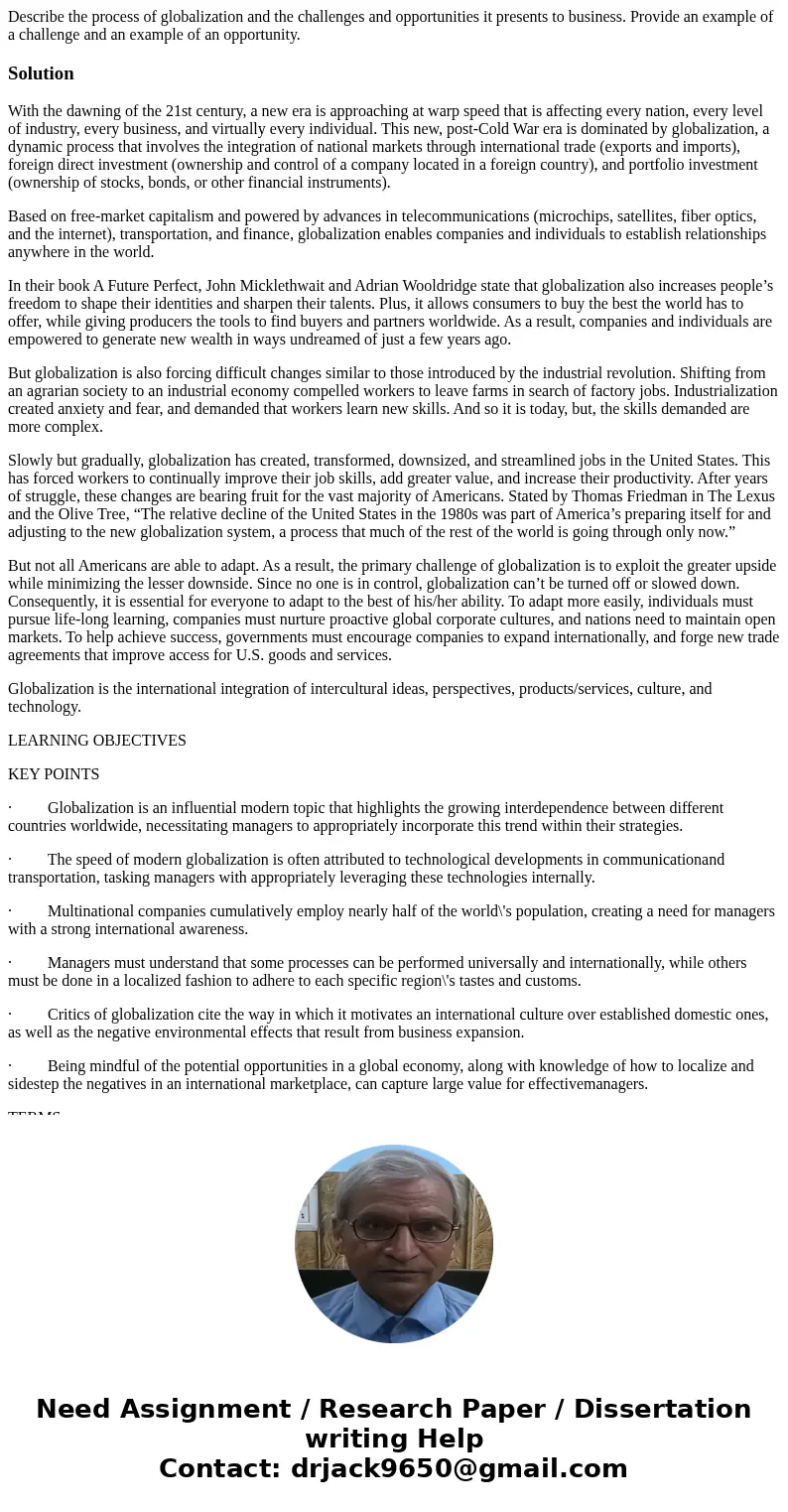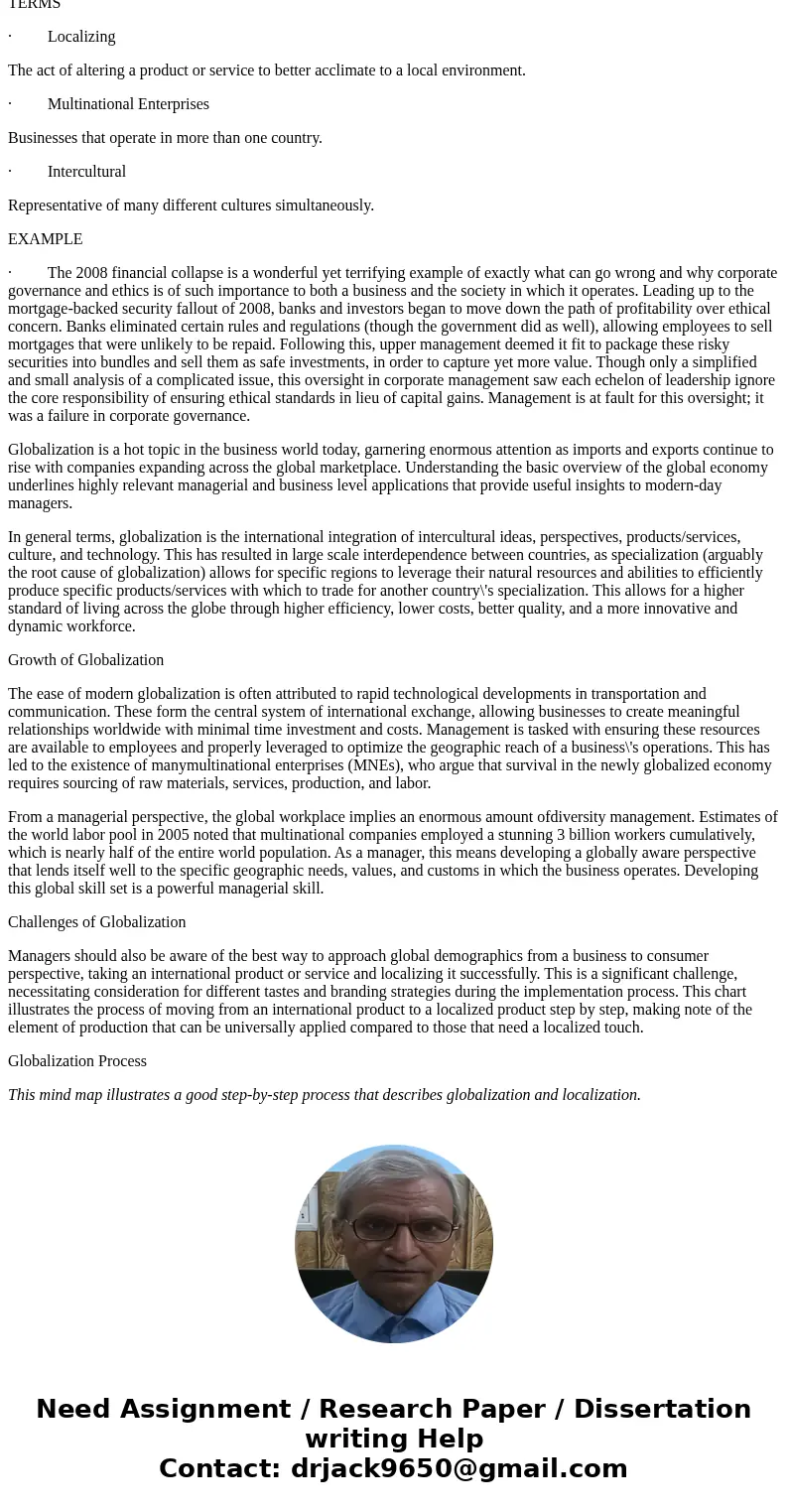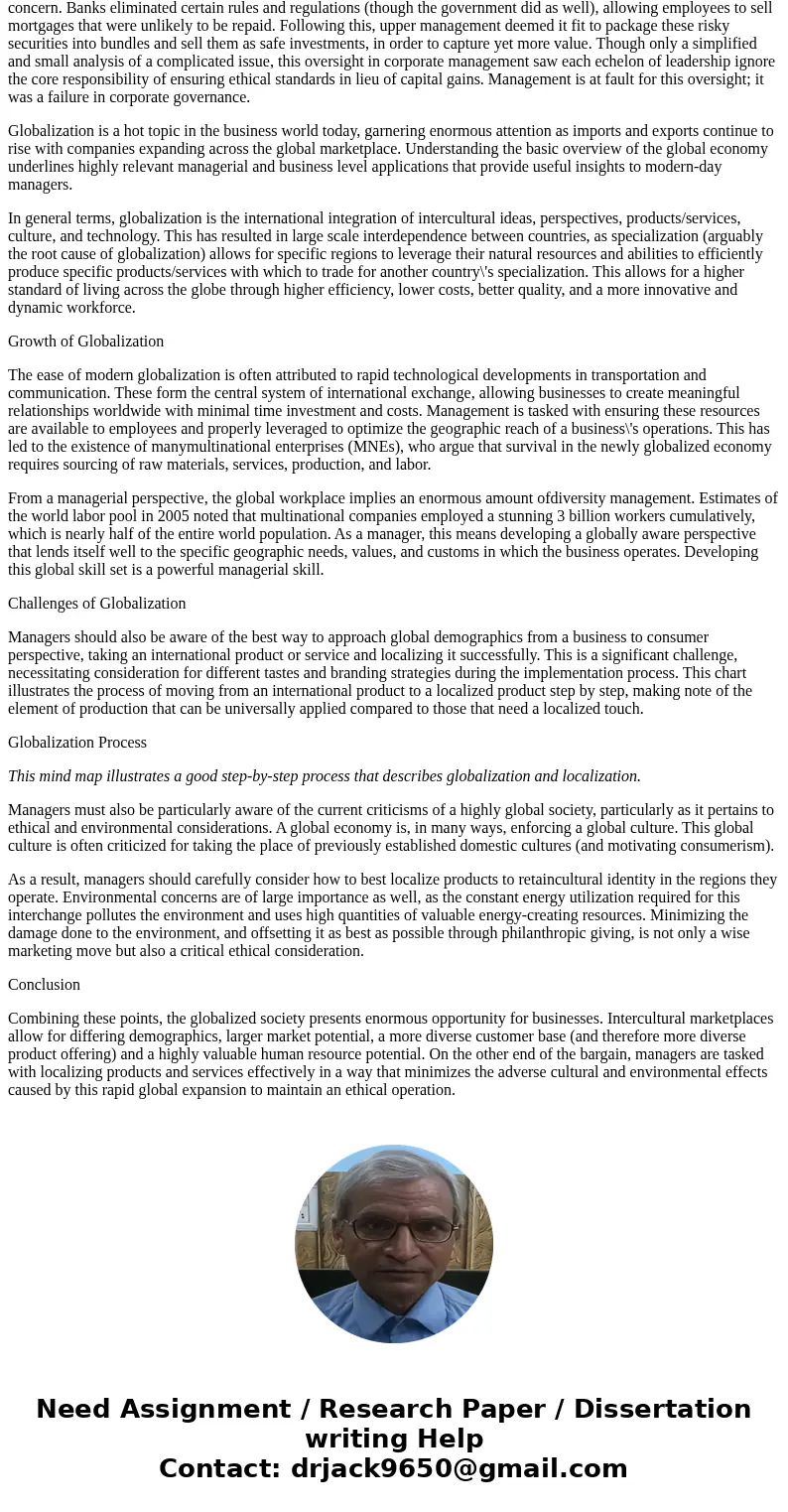Describe the process of globalization and the challenges and
Describe the process of globalization and the challenges and opportunities it presents to business. Provide an example of a challenge and an example of an opportunity.
Solution
With the dawning of the 21st century, a new era is approaching at warp speed that is affecting every nation, every level of industry, every business, and virtually every individual. This new, post-Cold War era is dominated by globalization, a dynamic process that involves the integration of national markets through international trade (exports and imports), foreign direct investment (ownership and control of a company located in a foreign country), and portfolio investment (ownership of stocks, bonds, or other financial instruments).
Based on free-market capitalism and powered by advances in telecommunications (microchips, satellites, fiber optics, and the internet), transportation, and finance, globalization enables companies and individuals to establish relationships anywhere in the world.
In their book A Future Perfect, John Micklethwait and Adrian Wooldridge state that globalization also increases people’s freedom to shape their identities and sharpen their talents. Plus, it allows consumers to buy the best the world has to offer, while giving producers the tools to find buyers and partners worldwide. As a result, companies and individuals are empowered to generate new wealth in ways undreamed of just a few years ago.
But globalization is also forcing difficult changes similar to those introduced by the industrial revolution. Shifting from an agrarian society to an industrial economy compelled workers to leave farms in search of factory jobs. Industrialization created anxiety and fear, and demanded that workers learn new skills. And so it is today, but, the skills demanded are more complex.
Slowly but gradually, globalization has created, transformed, downsized, and streamlined jobs in the United States. This has forced workers to continually improve their job skills, add greater value, and increase their productivity. After years of struggle, these changes are bearing fruit for the vast majority of Americans. Stated by Thomas Friedman in The Lexus and the Olive Tree, “The relative decline of the United States in the 1980s was part of America’s preparing itself for and adjusting to the new globalization system, a process that much of the rest of the world is going through only now.”
But not all Americans are able to adapt. As a result, the primary challenge of globalization is to exploit the greater upside while minimizing the lesser downside. Since no one is in control, globalization can’t be turned off or slowed down. Consequently, it is essential for everyone to adapt to the best of his/her ability. To adapt more easily, individuals must pursue life-long learning, companies must nurture proactive global corporate cultures, and nations need to maintain open markets. To help achieve success, governments must encourage companies to expand internationally, and forge new trade agreements that improve access for U.S. goods and services.
Globalization is the international integration of intercultural ideas, perspectives, products/services, culture, and technology.
LEARNING OBJECTIVES
KEY POINTS
· Globalization is an influential modern topic that highlights the growing interdependence between different countries worldwide, necessitating managers to appropriately incorporate this trend within their strategies.
· The speed of modern globalization is often attributed to technological developments in communicationand transportation, tasking managers with appropriately leveraging these technologies internally.
· Multinational companies cumulatively employ nearly half of the world\'s population, creating a need for managers with a strong international awareness.
· Managers must understand that some processes can be performed universally and internationally, while others must be done in a localized fashion to adhere to each specific region\'s tastes and customs.
· Critics of globalization cite the way in which it motivates an international culture over established domestic ones, as well as the negative environmental effects that result from business expansion.
· Being mindful of the potential opportunities in a global economy, along with knowledge of how to localize and sidestep the negatives in an international marketplace, can capture large value for effectivemanagers.
TERMS
· Localizing
The act of altering a product or service to better acclimate to a local environment.
· Multinational Enterprises
Businesses that operate in more than one country.
· Intercultural
Representative of many different cultures simultaneously.
EXAMPLE
· The 2008 financial collapse is a wonderful yet terrifying example of exactly what can go wrong and why corporate governance and ethics is of such importance to both a business and the society in which it operates. Leading up to the mortgage-backed security fallout of 2008, banks and investors began to move down the path of profitability over ethical concern. Banks eliminated certain rules and regulations (though the government did as well), allowing employees to sell mortgages that were unlikely to be repaid. Following this, upper management deemed it fit to package these risky securities into bundles and sell them as safe investments, in order to capture yet more value. Though only a simplified and small analysis of a complicated issue, this oversight in corporate management saw each echelon of leadership ignore the core responsibility of ensuring ethical standards in lieu of capital gains. Management is at fault for this oversight; it was a failure in corporate governance.
Globalization is a hot topic in the business world today, garnering enormous attention as imports and exports continue to rise with companies expanding across the global marketplace. Understanding the basic overview of the global economy underlines highly relevant managerial and business level applications that provide useful insights to modern-day managers.
In general terms, globalization is the international integration of intercultural ideas, perspectives, products/services, culture, and technology. This has resulted in large scale interdependence between countries, as specialization (arguably the root cause of globalization) allows for specific regions to leverage their natural resources and abilities to efficiently produce specific products/services with which to trade for another country\'s specialization. This allows for a higher standard of living across the globe through higher efficiency, lower costs, better quality, and a more innovative and dynamic workforce.
Growth of Globalization
The ease of modern globalization is often attributed to rapid technological developments in transportation and communication. These form the central system of international exchange, allowing businesses to create meaningful relationships worldwide with minimal time investment and costs. Management is tasked with ensuring these resources are available to employees and properly leveraged to optimize the geographic reach of a business\'s operations. This has led to the existence of manymultinational enterprises (MNEs), who argue that survival in the newly globalized economy requires sourcing of raw materials, services, production, and labor.
From a managerial perspective, the global workplace implies an enormous amount ofdiversity management. Estimates of the world labor pool in 2005 noted that multinational companies employed a stunning 3 billion workers cumulatively, which is nearly half of the entire world population. As a manager, this means developing a globally aware perspective that lends itself well to the specific geographic needs, values, and customs in which the business operates. Developing this global skill set is a powerful managerial skill.
Challenges of Globalization
Managers should also be aware of the best way to approach global demographics from a business to consumer perspective, taking an international product or service and localizing it successfully. This is a significant challenge, necessitating consideration for different tastes and branding strategies during the implementation process. This chart illustrates the process of moving from an international product to a localized product step by step, making note of the element of production that can be universally applied compared to those that need a localized touch.
Globalization Process
This mind map illustrates a good step-by-step process that describes globalization and localization.
Managers must also be particularly aware of the current criticisms of a highly global society, particularly as it pertains to ethical and environmental considerations. A global economy is, in many ways, enforcing a global culture. This global culture is often criticized for taking the place of previously established domestic cultures (and motivating consumerism).
As a result, managers should carefully consider how to best localize products to retaincultural identity in the regions they operate. Environmental concerns are of large importance as well, as the constant energy utilization required for this interchange pollutes the environment and uses high quantities of valuable energy-creating resources. Minimizing the damage done to the environment, and offsetting it as best as possible through philanthropic giving, is not only a wise marketing move but also a critical ethical consideration.
Conclusion
Combining these points, the globalized society presents enormous opportunity for businesses. Intercultural marketplaces allow for differing demographics, larger market potential, a more diverse customer base (and therefore more diverse product offering) and a highly valuable human resource potential. On the other end of the bargain, managers are tasked with localizing products and services effectively in a way that minimizes the adverse cultural and environmental effects caused by this rapid global expansion to maintain an ethical operation.



 Homework Sourse
Homework Sourse